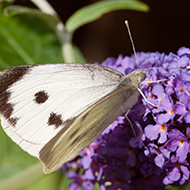
Figures from the 2020 Big Butterfly Count revealed.
The average number of butterflies in the UK has fallen to its lowest in eleven years, figures from the 2020 Big Butterfly Count reveal.
Each year, members of the public are asked to spend 15 minutes outside during sunny conditions and count the types and amount of butterflies they see. This year's figures, however, show there was a fall in the average number of butterflies logged per count of -34 per cent in comparison with 2019.
More than 1.4 million butterflies were counted across the UK, but the average number logged overall was the lowest since the event began eleven years ago. The full results from the count can be found here.
Dr Zoë Randle, senior surveys officer at Butterfly Conservation, said: “Unfortunately, this summer has not seen an abundance of butterflies, across the UK. We do see peaks and troughs of butterfly numbers each year (last year, for example, we saw a huge influx of migrant Painted Lady butterflies), so the data from the Big Butterfly Count is an important snapshot which, along with our other monitoring schemes, helps our understanding of the rates of decline of butterflies and moths”.
This year's Count saw the highest number of butterfly sightings ever submitted by the general public, with 111,628 participants submitting a record-breaking 145,249 counts this year - an increase of 25 per cent on 2019. Dr Zoe Randle said that the fall in butterfly numbers could be due to a number of factors:
“An unusually warm spring led many species to emerge earlier than usual. So we may have only caught the tail-end of the flight period for many species during this year’s Big Butterfly Count,” she said.“It’s important to look at butterfly trends over longer periods, so our scientists will be using these results alongside our other datasets to get a clearer understanding of what is happening."
Butterflies and moths are important indicators of the health of our environment. Their fall in numbers reveals not only the effects of human behaviour on the world but also changing weather patterns.
Butterflies also play key roles in the ecosystems of birds, mammals, invertebrates and plants, so their conservation is vitally important.
Julie Williams, CEO of Butterfly Conservation, said: “A huge thank you to everyone who took part in the Big Butterfly Count this year. This important data is so valuable to our ongoing and vital research helping us to understand what is happening to our butterflies and moths so we can take focused action to protect these fantastic insects and conserve them for future generations.”
Image (C) Peter Eeles



 The BSAVA has opened submissions for the BSAVA Clinical Research Abstracts 2026.
The BSAVA has opened submissions for the BSAVA Clinical Research Abstracts 2026.